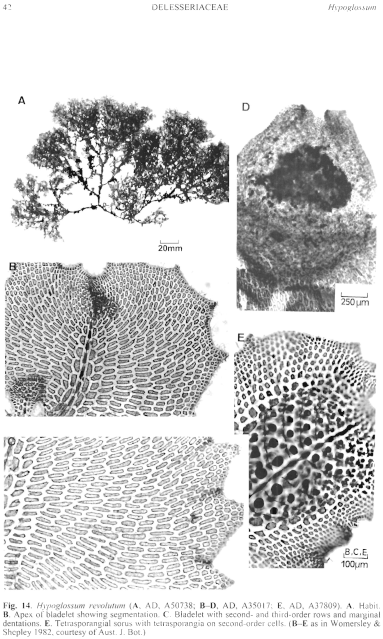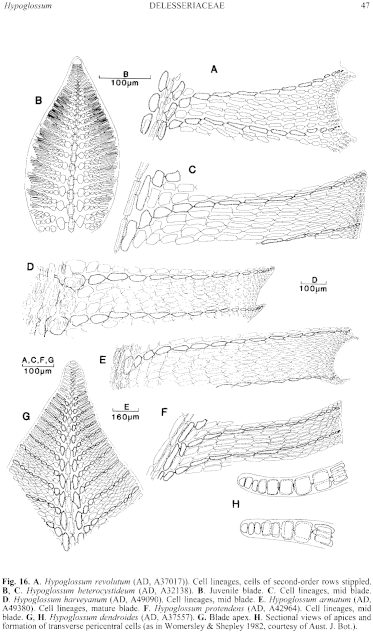|
|
|
|
|
|||||||||||
|
Electronic Flora of South Australia Species Fact Sheet
Phylum Rhodophyta – Family Delesseriaceae
Selected citations: De Toni 1900: 692. Huisman 1997: 201. Huisman & Walker 1990: 430. Kylin 1924: 9. Lucas 1909: 36. Lucas & Perrin 1947: 228, fig. 91. Shepherd & Womersley 1971: 166; 1981: 366. Silva et al. 1996: 459. Womersley 1950: 183. Womersley & Shepley 1982: 323, figs 1A, 3. Wynne 1989a: 514.
Synonyms
Delesseria revoluta Harvey 1855a: 548; 1860: pl. 170; 1863, synop.: xxxi. J. Agardh 1872: 57; 1876: 490. Sonder 1880: 24. Tate 1882a: 20. Tisdall 1898: 509. Wilson 1892: 174.
Delesseria denticulata J. Agardh 1894: 66, nom. illegit. [NON D. denticulata Harvey 1855a: 548 = Heterodoxia denticulata (Harvey) J. Agardh. NEC Montagne 1849: 290 = Membranoptera denticulata (Montagne) Kylin.]
Hypoglossum denticulatum J. Agardh 1898: 188. De Toni 1900: 693. Kylin 1924: 9. Lucas 1929b: 50.
?Placophora? cucullata J. Agardh 1892: 175.
Thallus (Fig. 14A) medium red to greenish brown, forming spreading clumps of one to a few axes with only very short stipes, attached by discoid primary (and often secondary) holdfasts. Branching entirely sympodial with new blades (often in clumps of 2–4) arising from some distance below the apex of parent blades on their adaxial (convex) side, with the ends of all blades being typically revolute. Mature blades 3–5 mm broad, with a distinct corticated midrib 300–600 µm across, and wings convolute with margins irregularly coarsely spinous. Holdfast 0.5–1 mm across; epiphytic on various algae. Structure. All second-order cells producing third-order rows (Figs 14B, C, 16A) with the outermost 2 or 3 cells much smaller than inner blade cells (Fig. 14B), produced singly or occasionally in pairs and in some plants extending as short 2- or 3-celled spinous projections, at first comprising second-order rows extending beyond the anterior third-order rows but later composed mainly of extended adjacent posterior third-order rows which usually cut off fourth-order cells both anteriorly and posteriorly (Figs 14B, 16A). Cortication of the midrib commences in young blades, and in mature blades extends almost to their apices; several layers of corticating cells form a broadly ovate to almost round midrib in section, but the lateral parts of the blades remain as wings throughout the thallus. Corticated midribs of older blades, either at their apices or below, often develop rhizoidal outgrowths which form secondary holdfasts. Mature cells multinucleate; rhodoplasts discoid.
Reproduction: Gametophytes dioecious. Procarps develop from the abaxial pericentral (supporting) cell, with a 4-celled carpogonial branch. Prior to fertilisation, the supporting cell cuts off an outer sterile cell which in turn produces a smaller sterile cell posteriorly. Several procarps may form in sequence, but usually on any blade only one procarp develops further. Carposporophyte with much branched gonimoblast filaments, with carposporangia developing terminally and sequentially but usually with chains of 2 or 3 maturing rapidly; subapical cells also produce carposporangia laterally. Carposporangia ovoid to pyriform, 25–45 µm in diameter. Cystocarps (Fig. 14D) develop on the abaxial (concave) side of young blades, becoming subspherical to slightly urceolate, not or only slightly basally constricted, 0.5–1.5 mm in diameter, with a small ostiole. Pericarp moderately corticated, 4–6 cells thick.
Type from King George Sound, W. Aust.; lectotype in Herb. Harvey, TCD (Trav. Set 311).
Selected specimens: Safety Bay, W. Aust. (Womersley, 26.viii.1979; AD, A50738). Elliston, S. Aust., 10–11 m deep in bay (Shepherd, 20.x.1969; AD, A35017) and outside bar, 25 m deep (Shepherd, 25.x.1971; AD, A42568). Muston, Kangaroo I., S. Aust., 2–3 m deep (Mitchell, 21.xi.1968; AD, A32135). Nora Creina, S. Aust., (Owen, 17.i.1971; AD, A37809) and uppermost sublittoral in shaded caverns (Womersley, 19.xii.1971; AD, A41162).
Distribution: Houtman Abrolhos, W. Aust. to Portland Bay, Victoria.
Taxonomic notes: Spermatangia not observed.
Tetrasporangia develop in broad sori (Fig. 14E) at the revolute apices of young blades. No third-order cell rows form within the sorus although they are present outside the sorus. Tetrasporangia arise first from the lateral pericentral cells and each second-order cell within the sorus, and at an early stage from the first-formed corticating cells so that the sorus contains tetrasporangia of varying ages. Just prior to initiation of the sporangium, 1 or 2 corticating cells are cut off from the second-order cells and 2 or 3 outer corticating cells are usually produced from the first-formed ones; tetrasporangia 50–80 µm in diameter.
Hypoglossum revolutum is readily recognised by the sympodial branching and revolute apices. H denticulatum (J. Agardh) J. Agardh is based on Harvey's Alg. Aust. Exsicc. 279B of H. revolutum, from King George Sound, W. Aust. The type is in Herb. Agardh (LD, 31570). The characters on which J. Agardh separated H. denticulatum (more prominent midrib and marginal teeth) are variable within H. revolutum.
Recorded from 2–50 m deep.
Placophora cucullata J. Agardh, from Fremantle, W. Aust., holotype in Herb. Agardh, LD, 42935, is a fragment 5–6 mm high of a Hypoglossum, possibly H. revolutum.
References:
AGARDH, J.G. (1872). Bidrag till Florideernes Systematik. Acta Univ. Lund 8, 1–60.
AGARDH, J.G. (1876). Species Genera et Ordines Algarum. Vol. 3, Part 1 - Epicrisis systematis Floridearum, pp. i-vii, 1–724. (Weigel: Leipzig.)
AGARDH, J.G. (1892). Analecta Algologica. Acta Univ. lund. 28, 1–182, Plates 1–3.
AGARDH, J.G. (1894). Analecta Algologica. Cont. II. Acta Univ. lund. 30, 1–98, Plate 1.
AGARDH, J.G. (1898). Species Genera et Ordines Algarum. Vol. 3, Part 3 - De dispositione Delesseriearum. (Gleerup: Lund.)
DE TONI, G.B. (1900). Sylloge Algarum omnium hucusque Cognitarum. Vol. 4. Florideae. Sect. 2. pp. 387–776. (Padua.)
HARVEY, W.H. (1855a). Some account of the marine botany of the colony of Western Australia. Trans. R. Jr. Acad. 22, 525–566.
HARVEY, W.H. (1860). Phycologia Australica. Vol. 3, Plates 121–180. (Reeve: London.)
HARVEY, W.H. (1863). Phycologia Australica. Vol. 5, Plates 241–300, synop., pp. i-lxxiii. (Reeve: London.)
HUISMAN, J.M. & WALKER, D.I. (1990). A catalogue of the marine plants of Rottnest Island, Western Australia, with notes on their distribution and biogeography. Kingia 1, 349–459.
HUISMAN, J.M. (1997). Marine Benthic Algae of the Houtman Abrolhos Islands, Western Australia. In Wells, F.E. (Ed.) The Marine Flora and Fauna of the Houtman Abrolhos Islands, Western Australia, pp. 177–237. (W. Aust. Museum: Perth.)
KYLIN, H. (1924). Studien über die Delesseriaceen. Lunds Univ. Årsskr. N.F. Avd. 2, 20(6), 1–111.
LUCAS, A.H.S. & PERRIN, F. (1947). The Seaweeds of South Australia. Part 2. The Red Seaweeds. (Govt Printer: Adelaide.)
LUCAS, A.H.S. (1909). Revised list of the Fucoideae and Florideae of Australia. Proc. Linn. Soc. N.S.W. 34, 9–60.
LUCAS, A.H.S. (1929b). A census of the marine algae of South Australia. Trans. R. Soc. S. Aust. 53, 45–53.
MONTAGNE, C. (1849). Sixième centurie de plantes cellulaires nouvelles, Décades viii-x. Annls Sci. Nat. (Bat.) Ser. 6, 12, 285–320.
SHEPHERD, S.A. & WOMERSLEY, H.B.S. (1971). Pearson Island Expedition 1969.-7. The subtidal ecology of benthic algae. Trans. R. Soc. S. Aust. 95(3), 155–167.
SHEPHERD, S.A. & WOMERSLEY, H.B.S. (1981). The algal and seagrass ecology of Waterloo Bay, South Australia. Aquat. Bot. 11, 305–371.
SILVA, P.C., BASSON, P.W. & MOE, R.L. (1996). Catalogue of the Benthic Marine Algae of the Indian Ocean. (Univ. California Press: Berkeley.)
SONDER, O.W. (1880). In Mueller, F., Fragmenta Phytographiae Australiae. Supplementum ad volumen undecinum: Algae Australianae hactenus cognitae, pp. 1–42, 105–107. (Melbourne.)
TATE, R. (1882a). A list of the charas, mosses, liverworts, lichens, fungs, and algals of extratropical South Australia. Trans. R. Soc. S. Aust. 4, 5–24.
TISDALL, H.T. (1898). The algae of Victoria. Rep. 7th Meet. Aust. Ass. Adv. Sci., Sydney, 1898, pp. 493–516.
WILSON, J.B. (1892). Catalogue of algae collected at or near Port Phillip Heads and Western Port. Proc. R. Soc. Viet. 4, 157–190.
WOMERSLEY, H.B.S. & SHEPLEY, E.A. (1982). Southern Australian species of Hypoglossum (Delesseriaceae, Rhodophyta). Aust. J. Bot. 30, 321–346.
WOMERSLEY, H.B.S. (1950). The marine algae of Kangaroo Island. III. List of Species 1. Trans. R. Soc. S. Aust. 73, 137–197.
WYNNE, M.J. (1989a). A reassessment of the Hypoglossum group (Delesseriaceae, Rhodophyta), with a critique of its genera. Helgol. Meeresunters. 42, 511–534.
The Marine Benthic Flora of Southern Australia Part IIID complete list of references.
Publication:
Womersley, H.B.S. (24 February, 2003)
The Marine Benthic Flora of Southern Australia
Rhodophyta. Part IIID. Ceramiales – Delesseriaceae, Sarcomeniaceae, Rhodomelaceae
Reproduced with permission from The Marine Benthic Flora of Southern Australia Part IIID 2003, by H.B.S. Womersley. Australian Biological Resources Study, Canberra. Copyright Commonwealth of Australia.
Illustrations in Womersley Part IIIA, 2003: FIGS 14, 16A.

Figure 14 enlarge
Fig. 14. Hypoglossum revolutum (A, AD A50738; B–D, AD, A35017; E, AD, A37809). A. Habit. B. Apex of bladelet showing segmentation. C. Bladelet with second- and third-order rows and marginal dentations. E. Tetrasporangial sorus with tetrasporangia on second-order cells. (B–E as in Womersley & Shepley 1982, courtesy of Aust. J. Bot.)

Figure 16 enlarge
Fig. 16. A. Hypoglossum revolutum (AD, A37017)). Cell lineages, cells of second-order rows stippled. B, C. Hypoglossum heterocystideum (AD, A32138). B. Juvenile blade. C. Cell lineages, mid blade. D. Hypoglossum harveyanum (AD, A49090). Cell lineages, mid blade. E. Hypoglossum armatum (AD, A49380). Cell lineages, mature blade. F. Hypoglossum protendens (AD, A42964). Cell lineages, mid blade. G, H. Hypoglossum dendroides (AD, A37557). G. Blade apex. H. Sectional views of apices and formation of transverse pericentral cells (as in Womersley & Shepley 1982, courtesy of Aust. J. Bot.).

|
Email Contact: State Herbarium of South Australia |

|